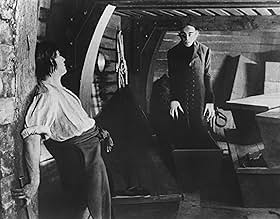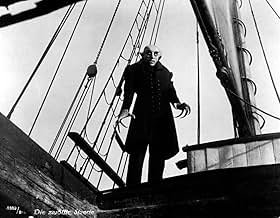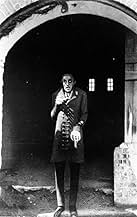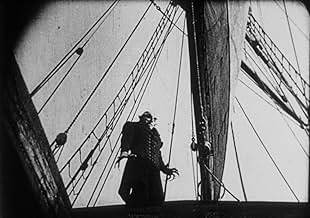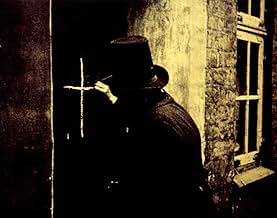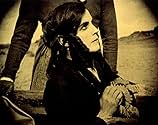Vampir Graf Orlok bekundet sein Interesse an einem neuen Wohnsitz, einschließlich der Ehefrau des Häusermaklers Hutter.Vampir Graf Orlok bekundet sein Interesse an einem neuen Wohnsitz, einschließlich der Ehefrau des Häusermaklers Hutter.Vampir Graf Orlok bekundet sein Interesse an einem neuen Wohnsitz, einschließlich der Ehefrau des Häusermaklers Hutter.
- Regie
- Drehbuch
- Hauptbesetzung
- Auszeichnungen
- 3 Gewinne & 2 Nominierungen insgesamt
Gustav von Wangenheim
- Hutter
- (as Gustav v. Wangenheim)
Greta Schröder
- Ellen - seine Frau
- (as Greta Schroeder)
Georg H. Schnell
- Harding - ein Reeder
- (as G.H. Schnell)
Karl Etlinger
- Kontrolleur am Kai
- (Nicht genannt)
Hans Lanser-Ludolff
- A magistrate
- (Nicht genannt)
Loni Nest
- Child at Window
- (Nicht genannt)
Fritz Rasp
- Knocks Mitarbeiter
- (Nicht genannt)
Josef Sareny
- Head Coachman
- (Nicht genannt)
Fanny Schreck
- Krankenschwester im Hospital
- (Nicht genannt)
Eric van Viele
- Matrose 2
- (Nicht genannt)
Empfohlene Bewertungen
For copyright reasons, Bram Stoker's novel was filmed with the names of the characters changed (Orlok for Dracula, for example) but otherwise the story remains the same: a young man goes on a trip to see a mysterious count in order to sell a house, leaving his bride behind, and finds that the creature he meets is not of this world.
As the extremely creepy Orlok, Max Schreck is brilliant, with his long fingernails and gaunt appearance. A triumph in early cinematic make-up. Gustav von Wangenheim portrays the confusion of the victim well, as does Greta Schroder as his wife. FW Murnau directed the film with flair, showing us not only shadowed vistas and abandoned castles, but the nature outside (foxes) and miniature worlds evolving under a microscope. This film sits well with his later 'Sunrise' in showing the effect of outside forces on a young couple, as well as being one of the key early horrors in its portrayal of Stoker's anti-hero.
This version of the Dracula tale remains one of the best, although all have some different perspective on the novel. On the strength of 'Nosferatu' alone, Murnau deserves his place as a true innovator of silent cinema.
As the extremely creepy Orlok, Max Schreck is brilliant, with his long fingernails and gaunt appearance. A triumph in early cinematic make-up. Gustav von Wangenheim portrays the confusion of the victim well, as does Greta Schroder as his wife. FW Murnau directed the film with flair, showing us not only shadowed vistas and abandoned castles, but the nature outside (foxes) and miniature worlds evolving under a microscope. This film sits well with his later 'Sunrise' in showing the effect of outside forces on a young couple, as well as being one of the key early horrors in its portrayal of Stoker's anti-hero.
This version of the Dracula tale remains one of the best, although all have some different perspective on the novel. On the strength of 'Nosferatu' alone, Murnau deserves his place as a true innovator of silent cinema.
F.W. Murnau's version of the 'Dracula' legend still remains as distinctive and memorable as ever. The enjoyable Bela Lugosi version is perhaps easier to watch, and strictly as light entertainment it might work better, and many later versions brought their own interpretations - but nothing matches "Nosferatu" for its engrossingly morbid atmosphere and its unusual interpretation of the main character.
Max Schreck and Murnau were able to create an image of the vampire that remains in your mind long after seeing it. Regardless of whether it or some other conception is closest to the 'true' Dracula (if such a thing even exists), it is quite effective, and it was particularly well-conceived for a silent screen version that cannot rely on dialogue to define a character. The settings and the story perfectly complement Schreck's weird character, creating an atmosphere full of constant strangeness, uncertainty, and foreboding.
It's unnecessary (and probably impossible) to make detailed comparisons among all the film versions of the Dracula character and legend. "Nosferatu" stands perfectly well on its own, as a unique and skillfully done adaptation of the story, and as one of the memorable classics of the silent era.
Max Schreck and Murnau were able to create an image of the vampire that remains in your mind long after seeing it. Regardless of whether it or some other conception is closest to the 'true' Dracula (if such a thing even exists), it is quite effective, and it was particularly well-conceived for a silent screen version that cannot rely on dialogue to define a character. The settings and the story perfectly complement Schreck's weird character, creating an atmosphere full of constant strangeness, uncertainty, and foreboding.
It's unnecessary (and probably impossible) to make detailed comparisons among all the film versions of the Dracula character and legend. "Nosferatu" stands perfectly well on its own, as a unique and skillfully done adaptation of the story, and as one of the memorable classics of the silent era.
I watched the Kartes Video Communications 1984 video cassette version on a 15 inch screen. Titles were in English. Film quality was good. Sound was matched to action. Cropping appeared good, and titles were completely visible. This should give an idea of the technical quality of the release I watched.
Nosferatu is one of the few silent movies with a significant following today. It deserves a following. The film is a suspense piece. Still it is paced nicely so that it feels tense in the right places but never goes long enough without something happening so as to be boring.
Visually Nosferatu forms the precedent for the vampire in movies. The main difference is that Count Nosferatu has more affinity with rat than bat. Aside from this the main stream image of the vampire is based heavily on Nosferatu. This film has been as influential on modern vampire mythology as the novel Dracula. It is based on the novel Dracula. Especially disturbing to me personally are NosferatuÕs twisted hands.
In terms of the filmÕs being silent, this should not put anyone off. The suspense/ horror genre fits well into this medium. I was lucky enough to see a version with music matched to the scenes, but if the copy you are watching has a bad sound track just play some music you like.
I recommend this film to anyone interested in the horror or suspense films. It is a bit of a cult film, but this does not keep it from being actually good.
Nosferatu is one of the few silent movies with a significant following today. It deserves a following. The film is a suspense piece. Still it is paced nicely so that it feels tense in the right places but never goes long enough without something happening so as to be boring.
Visually Nosferatu forms the precedent for the vampire in movies. The main difference is that Count Nosferatu has more affinity with rat than bat. Aside from this the main stream image of the vampire is based heavily on Nosferatu. This film has been as influential on modern vampire mythology as the novel Dracula. It is based on the novel Dracula. Especially disturbing to me personally are NosferatuÕs twisted hands.
In terms of the filmÕs being silent, this should not put anyone off. The suspense/ horror genre fits well into this medium. I was lucky enough to see a version with music matched to the scenes, but if the copy you are watching has a bad sound track just play some music you like.
I recommend this film to anyone interested in the horror or suspense films. It is a bit of a cult film, but this does not keep it from being actually good.
As I'm sure it is the case for many cinema fans, my respect and admiration towards this production widely excels the enjoyment I had while watching it. "Nosferatu" is a milestone from every possible viewpoint and it's one of those very few movies I think everybody should view at least once (although it actually requires repeated viewings
) It is the very first version of Bram Stoker's legendary vampire tale and easily the most copied film in the history of cinema. I'm sure everyone is familiar with the story of young estate agent Jonathan Harker traveling to Transylvania where he acquaintances the eccentric count who feeds on blood and controls the ones he has bitten, but THIS is the original version. Shot by F.W. Murnau (who also made the equally essential titles "Faust" and "Der Januskopf") and made unforgettable by Max Schreck in his performance as the Count. And, even though this film is over 80 years old, Schreck's image is still as nightmarish as it can be. No visual or make-up effect could ever surpass the simple appearance of Max Schreck! The fact that this film is still very powerful therefore almost entirely depends on his unworldly character. "Nosferatu" is beautiful poetry, difficult to watch at times, but very rewarding. The sexual undertones as well as the shock-aspects have surely dated by now, but they're still present, and as I mentioned before they only increase my respect for Murnau and his crew. A definite must see, just make sure you're in the right mood.
F.W. Murnau set the bar high for vampire movies, very high. Can not help but start praising the job Max Schreck and Murnau did to bring Count Orlok character to life on the screen. Orlok's face, hands and slender build along with his sly shuffling movements with the right camera angles and props brought a hell of a lot of general creepiness. The viewers in the twenties must have been shell shocked because they didn't tame it down which they most often did in this time period. For a full length silent feature film I found the time going fairly fast with a view dragged out scenes, that can be expected. The big bugaboo I have with Nosferatu though is the questionable ending being terribly anticlimactic. Regardless of the disappointing ending, Nosferatu is a killer film that is a must watch for horror or classic movie fans.
Wusstest du schon
- WissenswertesThe movie was banned in Sweden due to excessive horror. The ban was finally lifted in 1972.
- Patzer(at around 30 mins) When Hutter is writing his letter to Ellen in Count Orlok's castle, the paper that he is meant to be writing on is clearly blank throughout the scene.
- Zitate
Graf Orlok: Your wife has such a beautiful neck...
- Alternative VersionenThere are a confusing number of different surviving prints, restorations and alternate versions of Nosferatu. In the main, there are three 'complete' restorations and two incomplete, partially-restored versions. All five are available on DVD, while the latest two restorations, from 1995 and 2006, are also on Blu-ray. In addition there are countless low-quality public domain DVDs with different lengths, running speeds and soundtracks. All are derived from a single print held by the Museum of Modern Art (MoMA). They usually have replacement American intertitles and are always in black and white; the film was originally color tinted throughout and only meant to be seen that way. This comprehensive article explains all of them simply and clearly: Nosferatu: The Ultimate Blu-ray and DVD Guide.
- VerbindungenEdited into Boo (1932)
- SoundtracksJeux d'enfants - Galop
Written by Jack Norworth
[Plays during the croquet scene in the 2006 restoration]
Top-Auswahl
Melde dich zum Bewerten an und greife auf die Watchlist für personalisierte Empfehlungen zu.
Details
- Erscheinungsdatum
- Herkunftsland
- Offizieller Standort
- Sprachen
- Auch bekannt als
- Nosferatu
- Drehorte
- Starhrad Castle, Nezbudská Lúcka, Slowakei (Republik)(castle in ruins)
- Produktionsfirmen
- Weitere beteiligte Unternehmen bei IMDbPro anzeigen
Box Office
- Weltweiter Bruttoertrag
- 48.892 $
- Laufzeit
- 1 Std. 34 Min.(94 min)
- Sound-Mix
- Seitenverhältnis
- 1.33 : 1
Zu dieser Seite beitragen
Bearbeitung vorschlagen oder fehlenden Inhalt hinzufügen


